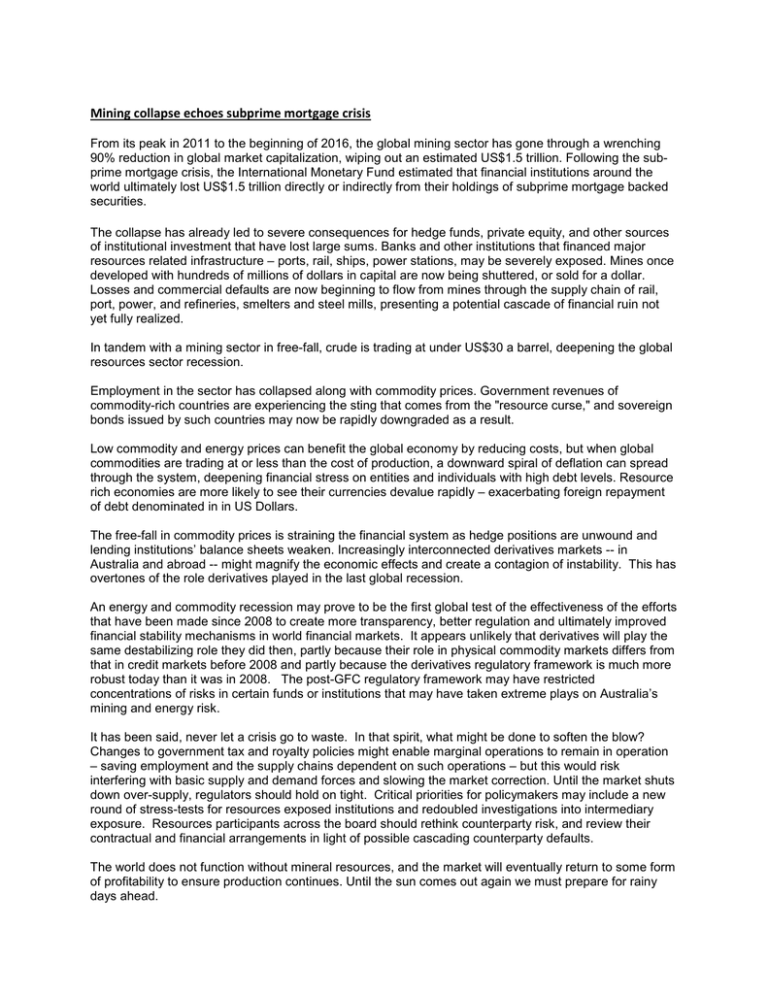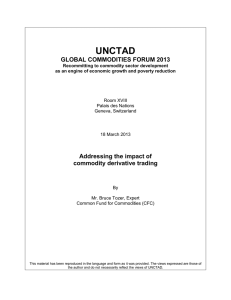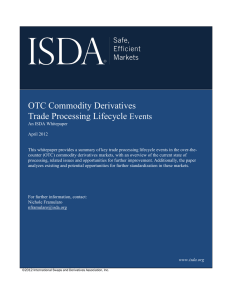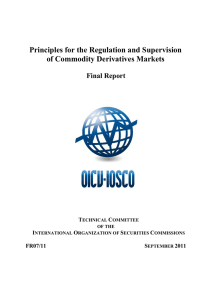Mining collapse echoes subprime mortgage crisis
advertisement

Mining collapse echoes subprime mortgage crisis From its peak in 2011 to the beginning of 2016, the global mining sector has gone through a wrenching 90% reduction in global market capitalization, wiping out an estimated US$1.5 trillion. Following the subprime mortgage crisis, the International Monetary Fund estimated that financial institutions around the world ultimately lost US$1.5 trillion directly or indirectly from their holdings of subprime mortgage backed securities. The collapse has already led to severe consequences for hedge funds, private equity, and other sources of institutional investment that have lost large sums. Banks and other institutions that financed major resources related infrastructure – ports, rail, ships, power stations, may be severely exposed. Mines once developed with hundreds of millions of dollars in capital are now being shuttered, or sold for a dollar. Losses and commercial defaults are now beginning to flow from mines through the supply chain of rail, port, power, and refineries, smelters and steel mills, presenting a potential cascade of financial ruin not yet fully realized. In tandem with a mining sector in free-fall, crude is trading at under US$30 a barrel, deepening the global resources sector recession. Employment in the sector has collapsed along with commodity prices. Government revenues of commodity-rich countries are experiencing the sting that comes from the "resource curse," and sovereign bonds issued by such countries may now be rapidly downgraded as a result. Low commodity and energy prices can benefit the global economy by reducing costs, but when global commodities are trading at or less than the cost of production, a downward spiral of deflation can spread through the system, deepening financial stress on entities and individuals with high debt levels. Resource rich economies are more likely to see their currencies devalue rapidly – exacerbating foreign repayment of debt denominated in in US Dollars. The free-fall in commodity prices is straining the financial system as hedge positions are unwound and lending institutions’ balance sheets weaken. Increasingly interconnected derivatives markets -- in Australia and abroad -- might magnify the economic effects and create a contagion of instability. This has overtones of the role derivatives played in the last global recession. An energy and commodity recession may prove to be the first global test of the effectiveness of the efforts that have been made since 2008 to create more transparency, better regulation and ultimately improved financial stability mechanisms in world financial markets. It appears unlikely that derivatives will play the same destabilizing role they did then, partly because their role in physical commodity markets differs from that in credit markets before 2008 and partly because the derivatives regulatory framework is much more robust today than it was in 2008. The post-GFC regulatory framework may have restricted concentrations of risks in certain funds or institutions that may have taken extreme plays on Australia’s mining and energy risk. It has been said, never let a crisis go to waste. In that spirit, what might be done to soften the blow? Changes to government tax and royalty policies might enable marginal operations to remain in operation – saving employment and the supply chains dependent on such operations – but this would risk interfering with basic supply and demand forces and slowing the market correction. Until the market shuts down over-supply, regulators should hold on tight. Critical priorities for policymakers may include a new round of stress-tests for resources exposed institutions and redoubled investigations into intermediary exposure. Resources participants across the board should rethink counterparty risk, and review their contractual and financial arrangements in light of possible cascading counterparty defaults. The world does not function without mineral resources, and the market will eventually return to some form of profitability to ensure production continues. Until the sun comes out again we must prepare for rainy days ahead. -Robert Milbourne is a partner in the Brisbane office of K&L Gates and an adjunct professor at the University of Queensland. Anthony Nolan is a partner in the New York office of K&L Gates and a Lecturer in Law at the Columbia University School of Law



